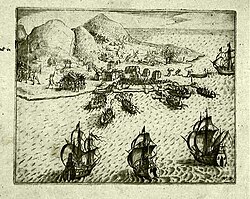Capture of Amboina
| Capture of Amboina | |||||||
|---|---|---|---|---|---|---|---|
| Part of Dutch–Portuguese War | |||||||
 The Dutch and Hitu defeated the Portuguese at Amboina in 1605. Engraved by Isaac Commelin in 1645. | |||||||
| |||||||
| Belligerents | |||||||
|
|
| ||||||
| Commanders and leaders | |||||||
| Steven van der Hagen |
Gaspar de Mello | ||||||
The Capture of Amboina was the capture of the Portuguese fort Nossa Senhora de Anunciada in Amboina by the Dutch East India Company, under admiral Steven van der Hagen. The Portuguese governor of Ambon Gaspar de Melo surrendered the fort on 22 February 1605 to the Dutch forces, the fort was renamed to fort Victoria, and Ambon was placed under Dutch Control. The capture was one of the last major defeat of the Portuguese in the Moluccas.
The capture[edit]
The Portuguese presence in the Moluccas has already deteriorated since the loss of Ternate in 1575, they had to face serious threats from both the new emerging regional power from the Sultanate of Ternate, and the Dutch East India Company (VOC) that had been established in 1602.[2] In the earlier years, the VOC had no controlled territories other than Amboina which they captured in 1605.[3]
In 1603, the Dutch East India Company admiral, Steven van der Hagen launched his second voyage to the Indies, van der Hagen's fleet consisting of 12 fleets left Holland in December 1603, visited several ports of the Malabar coast and Ceylon, stopped at Aceh and Bantam before arriving in Amboina in 1605.[4] In February 1605, van der Hagen allied with the raja of Hitu in an improvised attack and capture of Amboina,[5] when 14 Dutch sail appeared before Amboina on 22 February 1605, the last Portuguese commander of Amboina, Gaspar de Mello quickly surrendered the castle of Nossa Senhora de Anunciada[6] with everything they had there under a treaty,[3] leaving Amboina under Dutch control, and after capturing the Portuguese fort in Amboina, van der Hagen's fleet was divided. The capture of Amboina and Tidore was described in a 1645 journal titled Begin ende voortgangh van de Vereenighde Nederlantsche Geoctroyeerde Oost-Indische Compagnie by a Dutch historian, Isaac Commelin.[4]
Ambon became the headquarters of the Dutch East India Company (VOC) from 1610 to 1619 until the founding of Batavia, now Jakarta, by the Dutch.[7]
Notes[edit]
- ^ Johannes Keuning (1973). Sejarah Ambon sampai pada akhir abad ke-17. Bhratara. p. 22. Retrieved 30 March 2023.
- ^ Charles F. Doran; Chris Dixon (July 26, 1991). South East Asia in the World-Economy. Cambridge University Press. p. 63. ISBN 9780521312370. Retrieved 30 March 2023.
- ^ a b Valentyn 1726, pp. 273.
- ^ a b F. Lach 1993, pp. 467.
- ^ Charles H. Parker (2022). Global Calvinism Conversion and Commerce in the Dutch Empire, 1600-1800. Yale University Press. p. Trade and Empire. ISBN 9780300262605. Retrieved 30 March 2023.
- ^ Dauril Alden (1996). The Making of an Enterprise The Society of Jesus in Portugal, Its Empire, and Beyond, 1540-1750. Stanford University Press. p. 161. ISBN 9780804722711. Retrieved 30 March 2023.
- ^ Merle Calvin Ricklefs (1993). A history of modern Indonesia since c. 1300. Stanford University Press. p. 25. ISBN 9780804721950. Retrieved 30 March 2023.
References[edit]
- Begin ende voortgangh van de Vereenighde Nederlantsche Geoctroyeerde Oost-Indische Compagnie : Vervatende de voornaemste reysen, by de inwoonderen der selver provincien derwaerts gedaen..., Amsterdam: Johannes Janssonius, 1646 via archive.org
- F. Lach, Donald (1993). Asia in the Making of Europe Vol. 3. A century of advance / Donald F. Lach and Edwin J. Van Kley. Trade, missions, literature. Book 1. University of Chicago Press. Retrieved 30 March 2023.
- Valentyn, Francois (1726). Oud en nieuw Oost-Indiën (in Dutch). by Joannes van Braam. Retrieved 30 March 2023.
